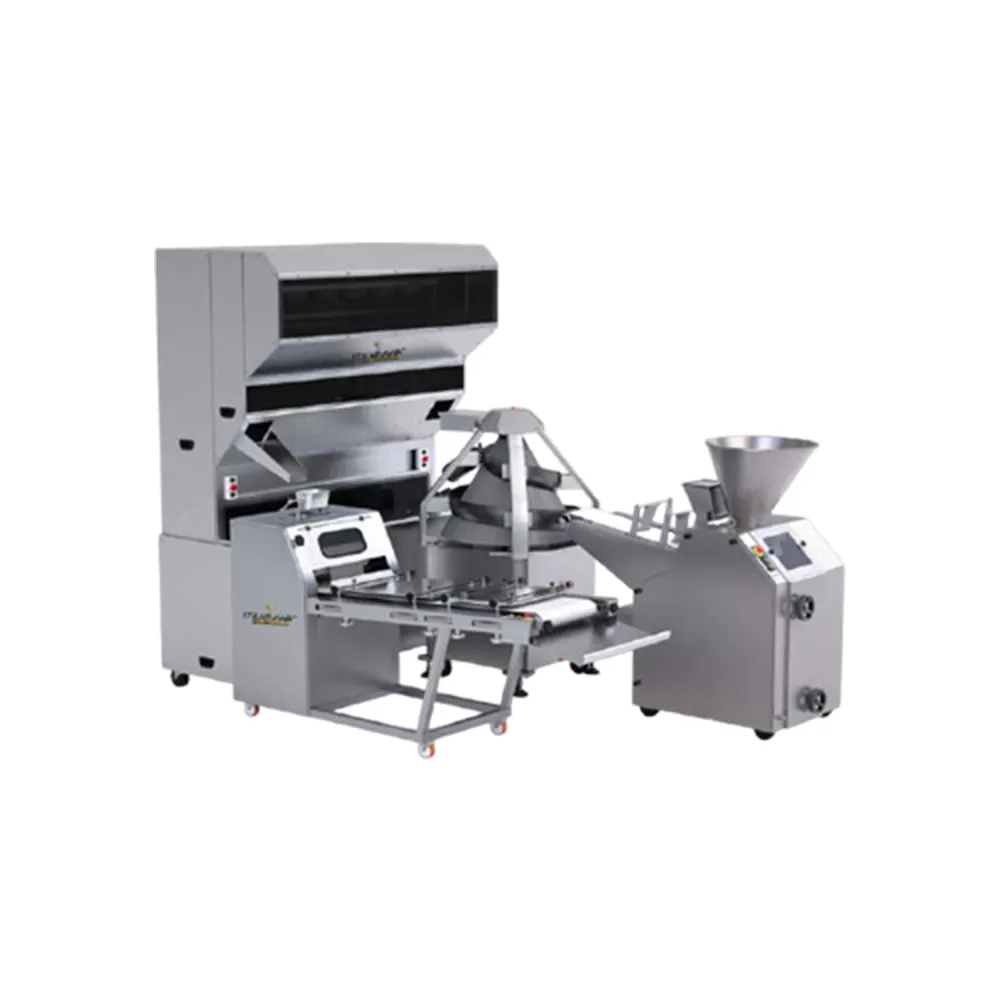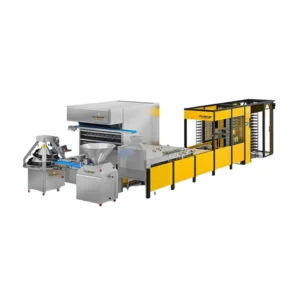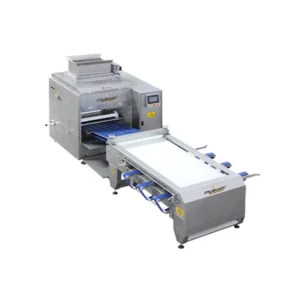Integrated Bread Line: Efficient Solutions
Technicial Specifications :
| Line Content | Integrated and Automatic Dough Kestart Dough Rounding (Turning) Machine Dough Intermediate Resting Machine Dough Long Forming Machine |
| Capacities | Roll and Hamburger Bread 480 pcs / Hour ( with 1 oven)Sandwich / Baguette Bread 480 pcs / Hour ( with 1 oven)Toast Bread 90 Pcs / Hour ( with 1 oven ) |
| Control | PLC / Digital |
| Cutting Machine Boiler Capacity | 75 Kg |
| Dough Cutting Range | 40-200 / 100-600 g |
| Conveyor Speed Control | Yes |
| Dough Cutting Ability | 1 or 2 Equal Weight Doughs at the Same Time |
| Fat Consumption / Day | 1 liter |
| Line Width-Length-Height (m) | 3,5 – 3 – 2,5 |
| Line Weight | 1600 Kg |
| Electric power | 3 kW |
| Income | 380V 50-60Hz |
This line suitable for, hamburger, sandwich, bun, toast, baguette and other kinds of bread.
What machines are in the production line?
1 – Cutting Machine
This machine can cut 1 or 2 pieces of dough of equal weight at the same time. Dough weights are adjustable.
2-Dough Rounder Machine
This machine is used for compacting dough
3-Dough Intermediate Proofing Machine
This machine undertakes the resting task of the dough, which is the most important element for a quality bread.
4-Dough Moulder Machine
This machine is used for the production of a wide variety of breads. Like sandwich, baguette , hamburger , bun & roll or loaf style breads.
Revolutionizing Bread Production: The Integrated Bread Line
In the dynamic world of bread manufacturing, efficiency, consistency, and automation are key factors driving success. The integrated bread line stands as a pinnacle of modern bread production, offering a seamless and streamlined process from dough mixing to packaging. This detailed article explores the intricacies of the integrated bread line, examining its design, functionality, advantages, and diverse applications in commercial bakery settings.
Understanding the Integrated Bread Line:
1. Design and Components:
The integrated bread line is a comprehensive system that combines multiple machines and processes into a single, continuous production line.
It typically consists of various modules, including dough mixing, dough dividing and rounding, proofing, baking, cooling, slicing, and packaging.
2. Operating Principles:
The process begins with dough mixing, where ingredients are combined to form the dough.
The dough is then divided and rounded into uniform portions, proofed to allow fermentation, and finally baked to perfection.
After baking, the bread undergoes cooling, slicing, and packaging stages before being ready for distribution.
3. Key Features:
Automation and Integration: The integrated bread line is highly automated, with seamless integration between different modules, minimizing manual intervention and maximizing efficiency.
Customization Options: Operators can adjust settings and parameters to accommodate different types of bread, sizes, and production requirements, offering flexibility in production.
Quality Control: Advanced systems include sensors and monitoring devices to ensure consistent product quality throughout the production process, from dough mixing to packaging.
Space Efficiency: By combining multiple processes into a single line, the integrated bread line optimizes floor space in commercial bakery settings, maximizing production capacity.
Advantages of the Integrated Bread Line:
1. Efficiency and Productivity: By automating and integrating various production processes, the integrated bread line significantly reduces production time, labor costs, and manual errors, thereby increasing overall efficiency and productivity.
2. Consistency and Quality: The continuous and controlled production process ensures consistent product quality, texture, and taste, meeting consumer expectations and enhancing brand reputation.
3. Flexibility and Versatility: With customizable settings and modular designs, the integrated bread line can adapt to different bread types, sizes, and production volumes, providing flexibility for bakery operations.
4. Cost Savings: While the initial investment may be significant, the integrated bread line offers long-term cost savings through reduced labor costs, increased production capacity, and minimized product waste.
5. Hygiene and Food Safety: Advanced systems feature hygienic designs and easy-to-clean surfaces, ensuring compliance with food safety standards and maintaining optimal hygiene in bakery operations.
Conclusion:
The integrated bread line represents the epitome of efficiency, consistency, and automation in modern bread manufacturing. By seamlessly integrating multiple processes into a single, continuous production line, it offers unparalleled efficiency, productivity, and quality control in commercial bakery settings. With customizable options, space-efficient designs, and advanced features for hygiene and food safety, the integrated bread line continues to revolutionize bread production, meeting the demands of consumers and driving success in the competitive bakery industry.





Reviews
There are no reviews yet.